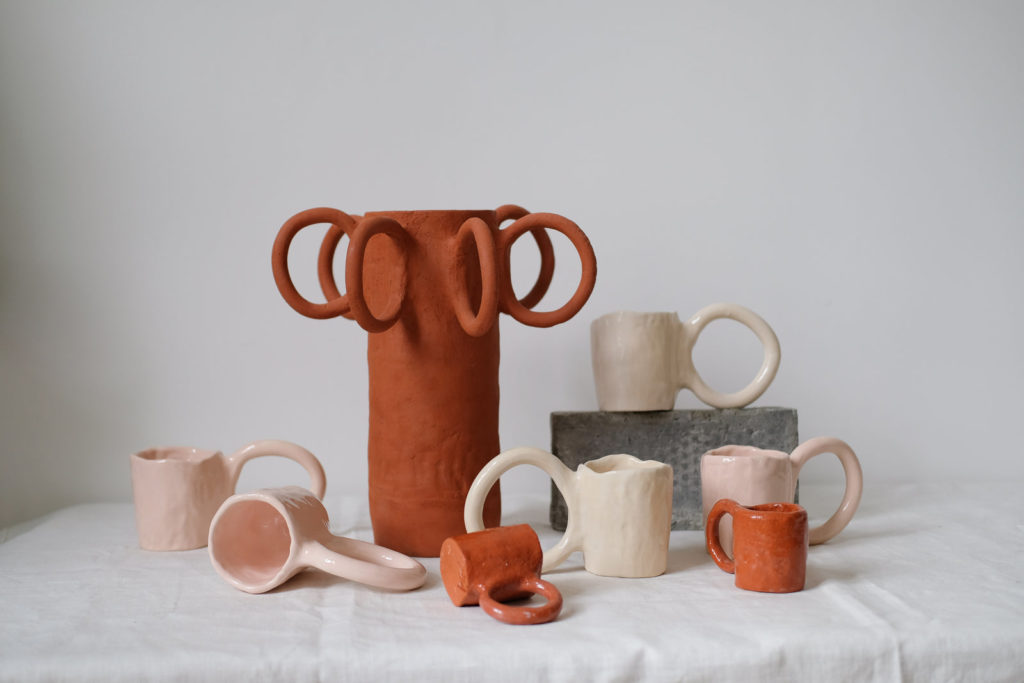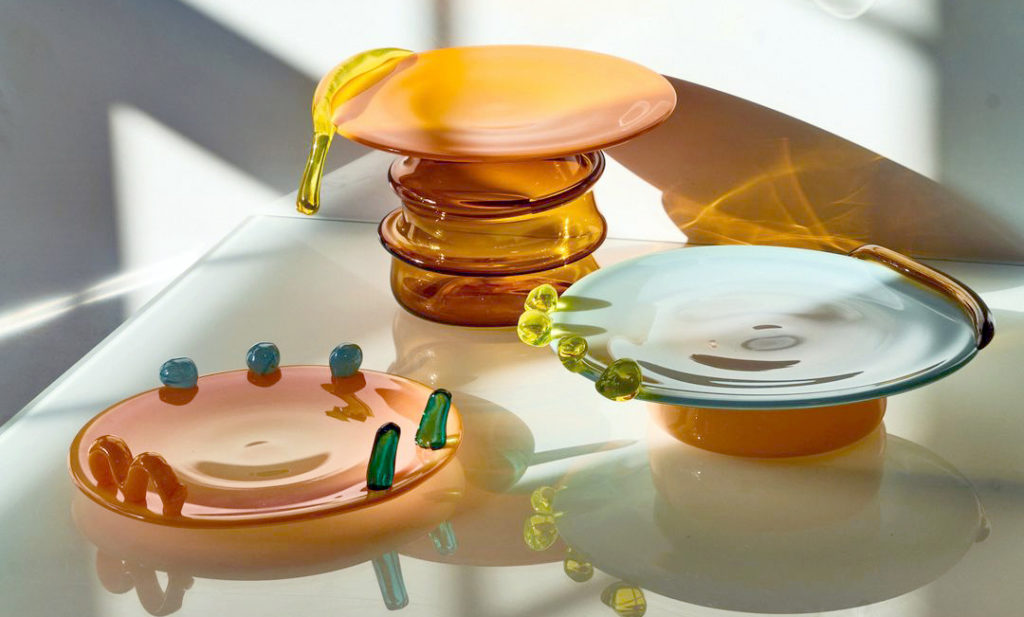Born in Moscow, Alissa Volchkova flew to the City of Light with her sister and mother in 1993, just two years after the fall of the USSR. The designer, who worked for a time as an interior architect, now devotes herself to designing objects, experimenting with techniques and juggling materials. On the occasion of her collaboration with GOODMOODS, the Parisian talks about her change of life, her fashion dreams, her love of children’s stories and the common thread that links all her creations. Meet the artist.
Did you grow up in a very artistic environment?
“My father was a businessman but my mother, a housewife, was always a very creative person: she drew and painted a lot. So did my grandmother, who also painted and made rugs. As for me, I was a very creative child and my parents always encouraged me. In Moscow, before we left for France in 1993, I practised piano. When I arrived in Paris, I continued drawing and painting and I took art classes at the Musée des Arts Décoratifs. It was obvious that I would make a career out of it later on.”
How did your creativity manifest itself as a child?
“I used to draw a lot, both comics and fairy tales that I illustrated. I was fascinated by Andersen’s writings and fairy tales, especially Russian and Swedish ones. This imagery influenced me a lot. The Russians are particularly fond of Andersen’s tales, which are part of the literature known to all children. Then, in France, I discovered Jean de la Fontaine, at the age of 9. During art classes, we had to sketch the bestiary of these fables, and my teachers liked my pictures very much. These exercises allowed me to develop my creativity even more.”
Yet you chose to go into architecture rather than art. Why did you do this?
“I was aware of how difficult it is to make a living from your art. So I looked for a more realistic path. I did a preparatory class at Penninghen, then trained as an interior designer at the Camondo school. After graduating and a few internships, notably with Gilles & Boissier, I returned to Russia to work alongside my father, who had not followed us to Paris and was still opening restaurants.
But spending my days in front of a computer was not for me. These kinds of projects always take a long time to start and it takes time to appreciate the results. On the other hand, our creativity is undermined by all the constraints we have to face. For someone like me, who needs to express what’s in my head right now, it can be frustrating. My father noticed that drawing plans did not make me happy. He pushed me to pursue my dream of studying at the Royal College of Arts in London, despite my age which held me back. Finally, at the age of 30, I got in!”
What did you learn from this experience?
“It was very difficult for me to put my life on hold. I had to concentrate 100% on my studies. But I don’t regret it, I learned so much from the course! I was fulfilled and I had more opportunities at the end of these two years than after Camondo: lots of projects, exhibitions… It wasn’t a waste of time at all.”
What is the work that made you famous?
“The Liquid Series, one of my final year projects, attracted a lot of media attention and put my work on the international scene. I was a ceramics and glass student at the Royal College of Arts, but unlike other students, I had no knowledge of these materials. I knew I was never going to become a master craftsman in just two years, nor did I want to choose between the two disciplines. I tried to turn this weakness into a strength. At first my teachers were sceptical: they found my approach too easy. I concentrated on moulding. For this project, I came up against a difficulty: I didn’t know how to make the edges of the plates. It was by experimenting with the liquid material of the porcelain that the Liquid Series came to life.”
Your projects are very eclectic. What do they have in common, the common thread in your work?
“I would say moulding and the imperfect side of my creations. I like my imperfections to show on my objects: it gives them a human side. I experiment with all sorts of materials – mainly glass and ceramics but also crystal and marble – and skills without mastering any of them 100%.
I particularly like the surprise of the final object and the techniques I use always allow the material to express itself spontaneously. I start the moulding and then the material reacts, does its work, which is quite magical, in my opinion. My objects are like members of a big family: imperfect and different. Sometimes I have no control over my work, and that’s good.”
What is your preferred palette?
“I love working with colours, which have a great effect on our minds. I recently immersed myself in The Secret Lives of Colour by Kassia St Clair, which talks about the history and origin of colours. For example, while today pink is associated with girls and blue with boys – although, fortunately, we are moving away from these clichés more and more – historically pink and red represented male power. Women, on the other hand, were more associated with blue, like the Virgin Mary. I was very attracted to greens, blues, or the combination of green and pink, which is very popular and which I still like to work with. These three shades are my favourite. My wardrobe is multicoloured and I find it very difficult to work with greys and browns.”
What about the Volcano series, which includes the pieces selected by GOODMOODS?
“I started developing this collection in 2016 at the Royal College when I was trying to learn glassblowing. I attempted to blow a bowl but the technique is so difficult, so physical that I quickly gave up – I now work with a glass blower, as glass blowing is a lifetime skill.
I had noticed that the end of the pieces coming out of the mould is cut off and then thrown away. I wanted to put this part forward, to exaggerate it. To show the irregularity of the glass which, the hotter it is, the more liquid it becomes. I made two very simple moulds – a bowl and a taller cylindrical vase – which are the basis of all these objects. The rest, the upper part, is totally random.”
Where does the name of the series come from Volcano ?
“Blowing, blowing the material out of the vase reminded me of an erupting volcano regurgitating material. The colour and texture of the molten glass also evokes lava.”
Pieces to be found on our shop!
What has shaped your taste?
“Living in France. Paris is the most beautiful city in the world, even if Parisians don’t necessarily realise it. When I arrived as a child, all the beauty dazzled me. The restaurants, the fashion, the streets, the views, everything is beautiful. I came from communist Russia and we had none of that. My sister and I visited a lot of museums, which influenced our vision of aesthetics.
At one point I wanted to become a fashion designer, because it was the great era of Valentino, John Galliano at Dior, Tom Ford at Gucci. I drew pages and pages of girls in evening gowns and copied outfits from magazines. I was obsessed with the catwalks in the golden age of top models, in the 90s.”
Is there a film set that stands out for you?
“I love Tim Burton, especially Edward Scissorhands and Charlie and the Chocolate Factory. This director manages to recreate the dream. Also, when I was a child in Russia, we didn’t have access to Disney cartoons. I grew up watching stop-motion films with very poetic wool characters.”
What is your Proust’s madeleine?
“Russian food, which takes me back to my homeland. These tastes and smells connect me to my childhood, my family and make me nostalgic for that time. I loved Russia very much and was very sad to leave it. I regularly prepare Russian dishes for myself and buy sweets and other typical biscuits in a grocery shop on the Boulevard des Batignolles in order to immerse myself in them.”
What are your latest favourite exhibitions?
“The Super Blue interactive installations I saw in Miami and the James Turrell exhibition at the Pace Gallery in Geneva, an art gallery run by my sister.”
Pieces to be found on our shop!
What Instagram accounts or magazines feed your inspiration?
“I try not to be influenced in general, so I avoid being tempted too much by Instagram. Instead, for inspiration, I visit museums, look at old books, look at antique and prehistoric objects, the basis for all my projects. Sometimes I leaf through design magazines, but more to observe trends through the images and colours used.”




































